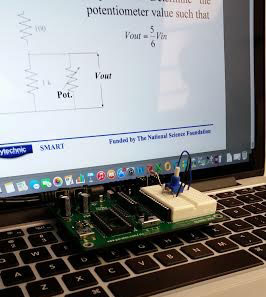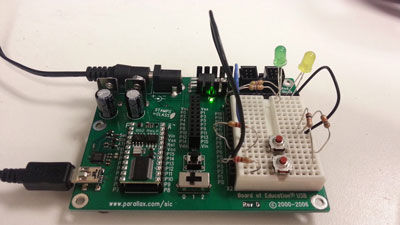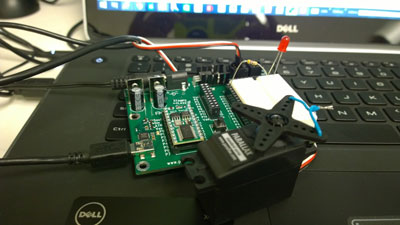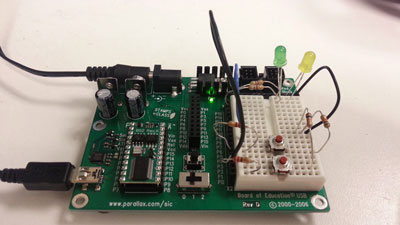Science and Mechatronics Aided Research for Teachers with an Entrepreneurship Experience (SMARTER)
2015: Week I
Phil Cook and Daniella DiLacqua
On July 6, 2015, 12 teachers of various disciplines and levels of experience began the SMARTER RET program at NYU Tandon. The morning session of our first day of the RET program was spent being introduced to a brief history of RET at NYU Tandon, which included an overview of previous projects. After an introduction and program overview by Professor Kapila and Ph.D. candidate Jared Alan Frank, the teachers completed their first task a pre-assessment on principles of circuitry and mechatronics. At that moment, we discovered the uncomfortable feelings our students face when they are given diagnostic testing. It certainly set our expectations of all the principles we hope to learn this summer. We were also introduced to our fellow participants in the program, and were provided project kits which we would use throughout the duration of the training sessions to become familiar with the interplay of software and hardware. After lunch, Jared lectured on the basics of circuitry that was followed by a laboratory experience with the teachers in teams. This first lesson focused on resistors and during lab activities we created several circuits involving series and parallel connections of resistors, and we characterized the circuits in terms of current, voltage and resistance using theoretical calculations as well as direct measurement using tabletop and handheld multimeters. It should be a fascinating and challenging summer as we move from the foundations of mechatronics to craft research projects that we can bring back to our classrooms.
Iulian Irimina and Phil Cook
Today we’ve built on prior’s day work and added new knowledge and skills to our foundation of building circuits. Our second day started with Jared’s presentation of potentiometers and capacitors after which he provided an overview of the exciting field of Mechatronics. Mechatronics uses elements from control theory, computer science, mechanical and electrical Engineering. After Jared’s lecture, we moved to the lab and shared solutions to the potentiometer problem posted a day before. Jared clarified the math aspect of the problem and answered our questions related to building the circuit on the breadboard. In the second half of the day, we’ve been introduced to the Basic Stamp microcontroller, a small computer about the size of a postage stamp that uses the PBasic programming language. During the lab, we wrote simple programs to get familiar with BS2 software and hardware. The exercises we completed in the lab underlined the importance of the BS2 variable types for writing future programs.

Lauren Schulman and Cathy Xiong
The third day began with a group lecture introducing the operating principles and the applications of diodes, LEDs, and seven-segment display. Circuit models were demonstrated. We then worked with our team members to explore the activities in the manual "What is a Microcontroller". We completed the activities in Chapter 2 and 6. Examples of the activities we did were building and testing the LED circuit, on/off control with the BASIC Stamp, counting and repeating, building and testing a second LED circuit, using current direction to control a bi-color LED, building and testing the 7-segment LED display.
The afternoon activity started by a lecture on the operating principle of digital inputs, namely pushbuttons, and we spent the rest of the day exploring the activities in Chapter 3. We ended the day by completing a project where we had to create a people counter that recorded the number of students who entered and exited a building. The skills that we learned in the earlier activities enabled us to solve this problem.

Marc Frank and Hau-yu Chu
Today we learned about DC motors and light sensors. We learned how DC motors work and how to use pulse width modulation to control the rotation of the motor and use H-bridge to control the direction of the rotation. DC motor turns by a torque created by the magnetic field generated when electric current flow through a coil of copper wire. The pulse width modulation works by supplying a sequence of high-low pulses, where the duration of pulses is controlled. The H-bridge consists of 4 switches. The rotation direction is controlled by closing or opening the switch pairs Q1/Q3 and Q2/Q4.
The servo motor is a DC motor with built-in position feedback control. The motor can hold at the same position as long as coded signal exists on the input line or power is still connected to the servo motor. For lab activities, we learned to control the Parallax standard servo motor with Pbasic pulsout command. In the afternoon lecture we learned about light sensors such as photo-resistor, phototransistor, and photodiode. Photo-resistor varies resistance corresponding to the light intensity. More light result in less resistance. Phototransistor converts light energy into electrical energy. Photodiode converts light into current. We did not work on the lab activities for light sensors yet and are still in the process of understanding these electronic devices.

Marc Frank and Ramona Fittipaldi
The fifth day began with a group lecture introducing the “analog-to-digital converter” (ADC). We learned that ADCs have the ability to take analog voltage input and output digital representation useful for Basic Stamp. The ADC performs a three-step procedure that includes sampling voltage, quantization of this voltage, and digital coding. The pins on the ADC include ground, power, chip select, input, offset, span, clock, and digital output. The hands-on activity for the morning explored Chapter 7, Measuring Lights from “What’s a Microcontroller”. We practiced using capacitors, LED, and phototransistors in the circuits. The use of RCTime function and corresponding hardware allowed an alternative approach to measuring analog variations in environmental signals. Jared demonstrated the inverted pendulum, which is seen in the picture to the right.
After lunch, Jared lectured on thermal sensors, both digital and analog. In addition, the lecture included op-amps, which is a low-cost and versatile IC consisting of many internal transistors, resistors, and other components. After the lecture, we continued to do hands-on work in the lab on the concepts from the morning session. We worked on activities from Chapter 1 (Analog Voltage and Binary States) and Chapter 3 (Basic Analog to Digital Conversion) from “Basic Analog and Digital”, seen in the picture to the right. Afterwards, Mike (an alumni from NYU’s RET Site SMARTER) stopped by and gave us advice on the presentation, poster, academic paper, engineering lesson (spend time on), and the “innovation challenge”.
